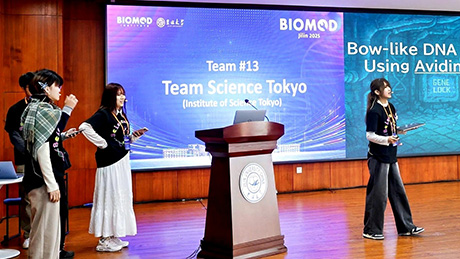Life Science and Technology News
Complete skin regeneration system of fish unraveled
Researchers at Tokyo Tech have succeeded in observing the bahavior of epidermal cells for the regeneration of smooth skin without remaining scar tissue using their model animal, the zebrafish.

Figure 1. Genetic labeling of regenerative epidermis
Cre-loxP was used as the cell-labeling technique. In this case, EGFP (enhanced green fluorescent protein) expression in the regenerative epidermis of zebrafish fins was switched on by using recombination enzyme Cre expressed under the regulation of the gene fibronectin 1b. Recombination can be induced by using a compound called tamoxifen (TAM).
*dpa: the number of days since amputation
Fish and amphibians such as newts are capable of advanced tissue regeneration and can regenerate tissue without scar tissue to their perfect original shape, should they lose organs such as their limbs. Unraveling the mechanisms of regeneration and homeostasis of tissues has been one of the main issues in recent biology, anticipated for its potential for application in human regenerative medicine. Not much had been known about the mechanism and the source of cells supplied in the regeneration of tissue.
The research group led by Tokyo Tech's Associate Professor Atsushi Kawakami, graduate student Eri Shibata, and others used the regeneration of zebrafish fins as a model and labeled the cells of the regenerative tissue with fluorescence (Figure 1) using a genetic cell-labeling technique (Cre-loxP site-specific recombination) and tracked their fates over weeks. As a result, they determined that epithelial cells near a wound follow heterogeneous cell fates.
The first group of epithelial cells which are initially recruited to the wound cover the wound but disappear within a few days by apoptosis. The second group of epithelial cells which arrive later become the cells forming the regenerated skin. However, many of these regenerated skin cells are moved toward the end of the fin and disappear about one to two weeks. In investigating the source of the replenishing skin cells, it was found that numerous new epithelial cells are supplied in the regeneration process by a large area of skin which contain stem cells and become active in cell proliferation. Intriguingly, it became clear that skin cells in the regeneration process do not undergo special processes such as de-differentiating into stem cells and regenerating, but existing stem cells in the basal layer and differentiated cells in the surface layer each proliferate with their own characteristics intact to regenerate the skin.
Based on this study, it is conceivable that regeneration of skin would become possible by controlling the autonomous proliferation of stem cells in the basal layer in other vertebrates as well, including humans. If the mechanism of skin regeneration discovered in this study proves to be the same in humans, it is expected to be used in the future to unravel the causes of various skin diseases, in regenerative medicine research, and for other purposes.
Reference
| Authors : | Eri Shibata, Kazunori Ando, Emiko Murase, and Atsushi Kawakami |
|---|---|
| Title of original paper : | Heterogeneous fates and dynamic rearrangement of regenerative epidermis-derived cells during zebrafish fin regeneration |
| Journal : | Development |
| DOI : | 10.1242/dev.162016 |
| Affiliations : | School of Life Science and Technology, Tokyo Institute of Technology |
- Elucidation of bone regeneration mechanism | Tokyo Tech News
- Inflammation in regeneration: a friend or foe? | Tokyo Tech News
- Fibroblast growth factor signalling controls fin regeneration in zebrafish | Tokyo Tech News
- Labs spotlight #20 - Kawakami Laboratory - | Life Science and Technology News
- Kawakami Laboratory (Japanese)
- Researcher Profile | Tokyo Tech STAR Search - Atsushi Kawakami
- Department of Life Science and Technology, School of Life Science and Technology
- Latest Research News
School of Life Science and Technology
—Unravel the Complex and Diverse Phenomena of Life—
Information on School of Life Science and Technology inaugurated in April 2016
Further Information
Associate Professor Atsushi Kawakami
School of Life Science and Technology,
Tokyo Institute of Technology
Email atkawaka@bio.titech.ac.jp
Tel +81-45-924-5717






